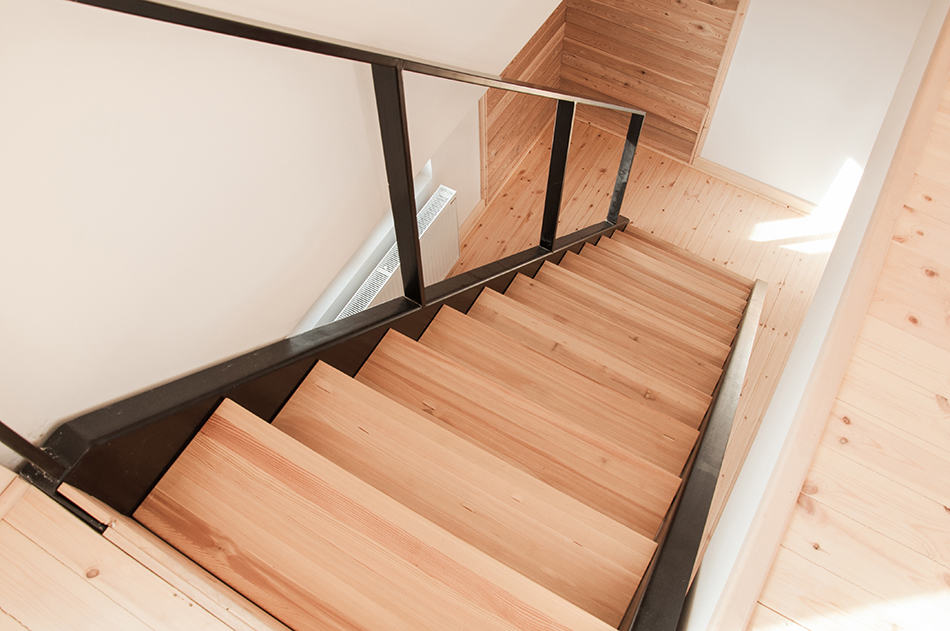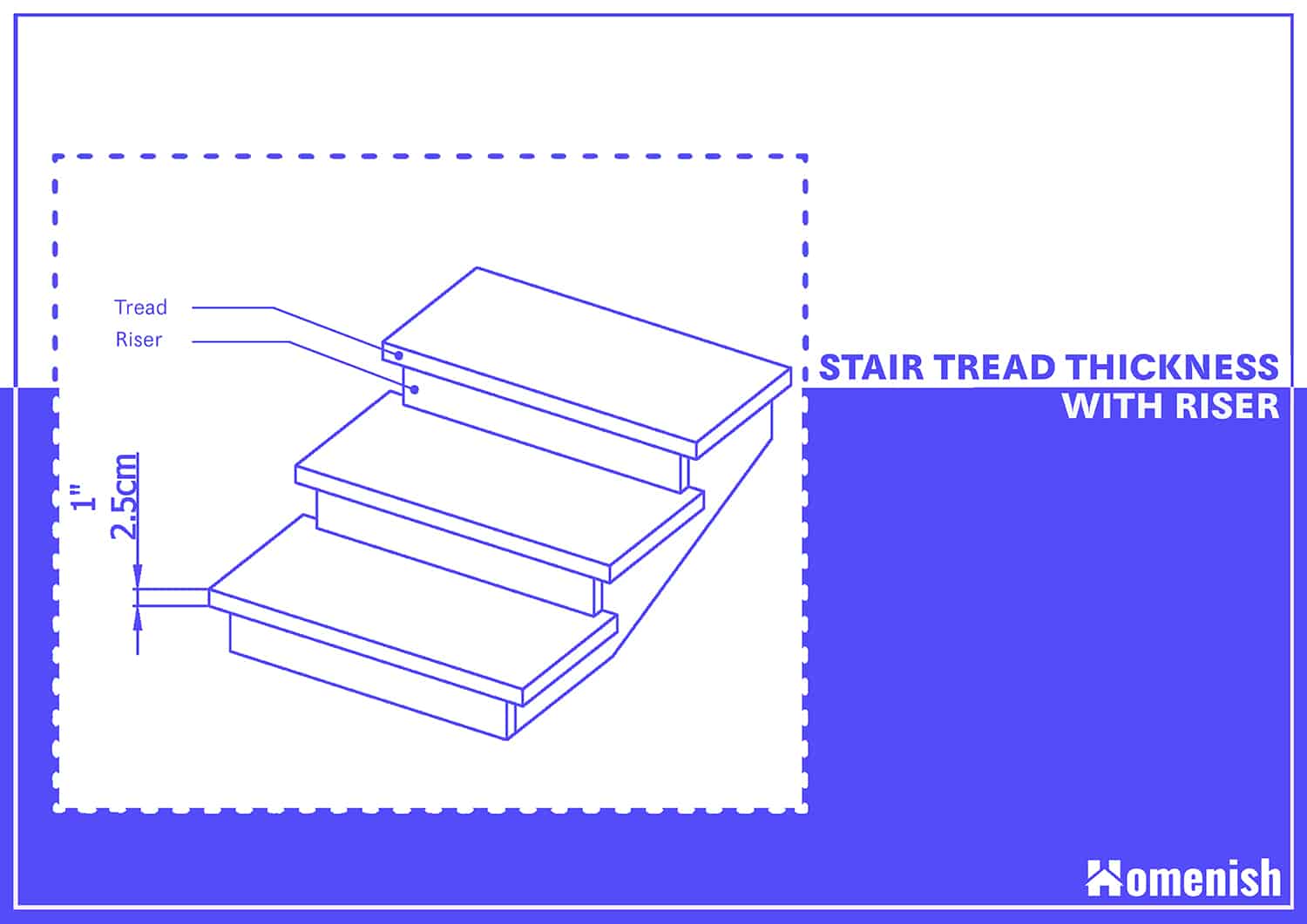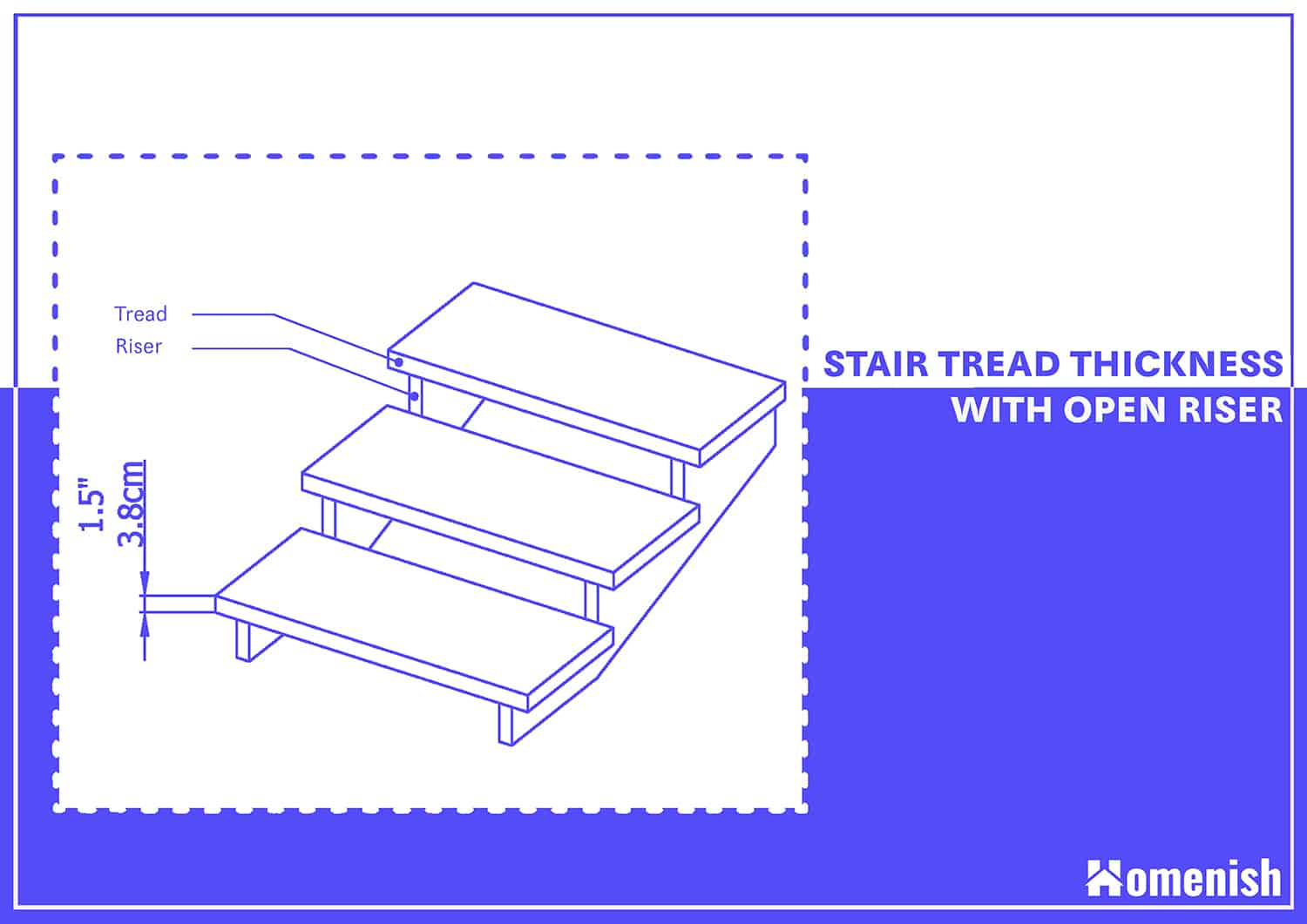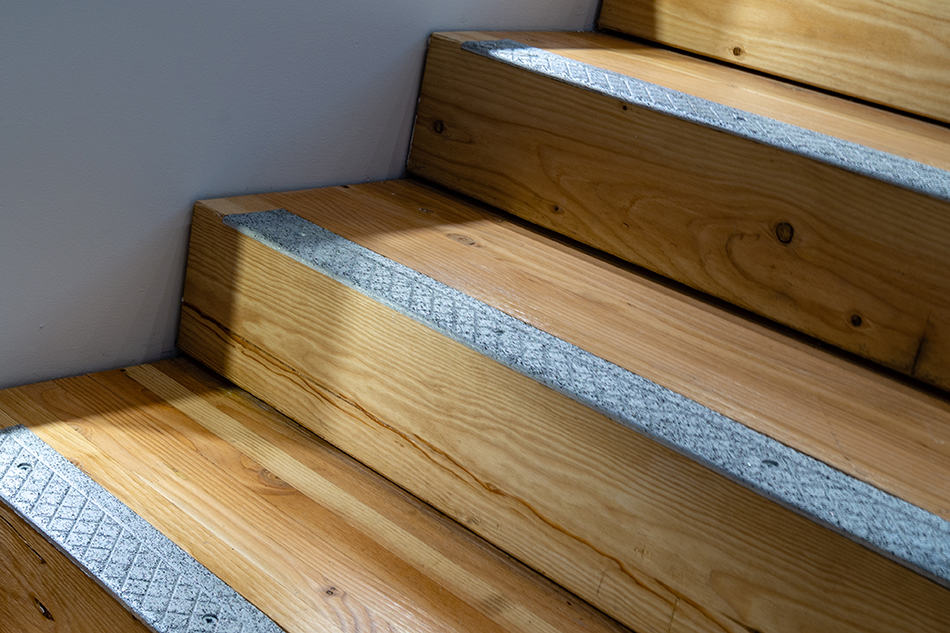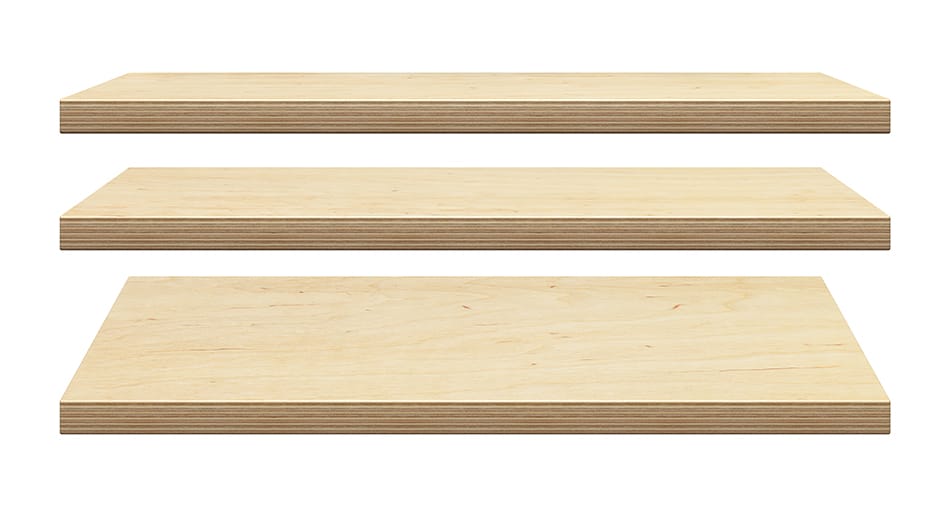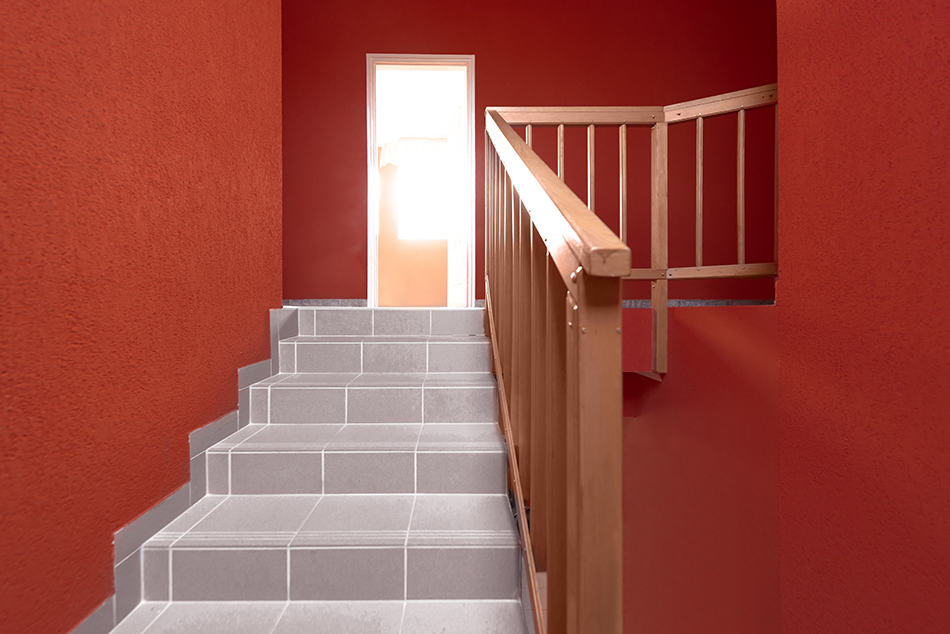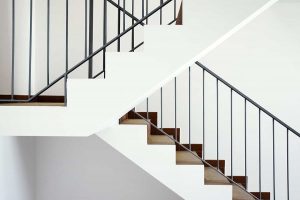Stair treads are the part of the stair that you step on. The thickness of a stair tread is vital because it can affect not only your comfort but your safety as well.
A tread that is too thin will not give you enough space to plant your foot safely. As a result, you may miss a step or slip. For this reason, it is vital to know the appropriate thickness of a stair tread, especially if you’re building a house. So, what is the standard stair tread thickness?
On average, for stairs that are supported by risers, wood stair treads will have a thickness of one inch (2.5cm). For stairs with open risers, the stair tread must be at least one and a half inches thick (3.8cm).
The Standard Stair Tread Thickness
Stair tread thickness is an important part of the stair dimensions, which include stair width, stair tread depth, stair riser height, vertical rise, etc.
According to the building code, a stair tread must be thick enough, so it can support a person as he goes up and down the stair.
With this in mind, most wood stair treads have a thickness of one inch. You can use this size if the stairs are supported by risers.
When used with open risers, the stair tread must at least have a thickness of one and a half inches.
Keep in mind that there is no standard thickness when it comes to stair treads because it will depend on the materials used. However, building codes have stated that the thickness of a stair riser, including the stair tread, must not go beyond seven and a half inches.
Although a stair tread doesn’t have a standard thickness, you should avoid stair treads that are too thick because they can cause accidents, like falls and trips. Still, thick treads can offer some benefits, such as durability.
As a general rule, if you’re using a lot of stairway stringers, you can use thin stair treads as long as the stair riser height and length meet the building codes. Meanwhile, if you’re going to use thicker stair treads, you only need to use a few stringers.
Wood Stair Treads
Wood is the most common type of stair tread used for the interior part of the house. You can also use wood for outdoor stairs; however, you need to consider the type of wood. The reason is that only a few wood species can handle outdoor weather elements. Some wood varieties that you can use outdoor are mahogany, white oak, and redwood.
For interior staircases, you can use various kinds of wood, including red oak, white oak, walnut, maple, and pine. Today, hardwood, like oak, is the most common type of stair tread. But, you can also use softwood, such as pine, as long as you use the right stair stringer numbers to support the tread.
However, softwood is not recommended if you’re planning to put a lot of weight on the stairs. For example, if you’re going to carry heavy appliances while going up and down the stairs, softwood won’t be able to handle the weight strain.
Aside from that, wood can be slippery. As such, you need to address this problem to avoid accidents. As a solution, you can use non-slip strips. If you want to maintain the natural beauty of the wood, you can opt for transparent non-slip strips.
Plywood as a Stair Tread
If you’re looking for an affordable stair tread, you can opt for plywood options. Aside from being durable, it is also easy to install. Plus, you can stain or paint it to make it look more appealing.
If you’re going to use plywood stair treads, you have to remember that they should be at least one inch thick. When used on an open riser, the plywood must be one and a half inches thick. Keep in mind that vinyl or carpet is not counted when computing the standard stair tread thickness because they are only meant for decorative purposes, and they don’t have load-bearing capabilities.
Aside from that, you can also place plywood below a pre-fabricated tread, like pine or oak stair treads. Through this, you can use a thinner pre-fabricated tread and save some money.
Other Materials Used for Stair Treads
Stone
Aside from wood, you can also opt for stone stair treads, especially if you’re going to build an outdoor staircase. Today, various types of stone are used for stair treads, including marble, granite, limestone, and bluestone.
Compared to wood, stone stair treads are more expensive, but they can last for years. Plus, they can handle outdoor weather elements. However, stone treads need proper care and maintenance. To be specific, you need to seal them at least once a year.
Glass
Like stone, glass is a beautiful material for stair tread, and it can give your staircase a one-of-a-kind look. Also, water can’t damage glass, so it is a good option for outdoor use.
Despite its various advantages, glass treads are expensive, and they are hard to install. Aside from that, it can be easily scratched. As such, if you have pets or children, glass stair treads are not a good option.
Tiles
Tile treads are usually used in private homes and commercial buildings. When used on a staircase near an entryway, it delivers a bold statement.
Compared to glass, tile treads are durable and scratch-resistant. As such, they can be a good choice for stairs with high traffic. Unlike wood stair treads, tile treads are not susceptible to insects and rotting. They are also water-resistant. However, tile treads can be slippery when wet. For this reason, they are not meant for outdoor use, especially if the staircase will be exposed to the rain.
Aluminum
Aluminum treads are typically used in commercial and residential buildings. Because this material is lightweight and corrosion-resistant, it is the ideal choice for roof stairs. Plus, aluminum treads are durable, and they can last for approximately 30 years. However, this type of stair tread is prone to scratches and dents. So, it is not a good choice for stairways with high traffic.
Laminate Flooring
Laminate flooring is a good choice for stair treads because it looks like a plank of real wood but cheaper. Additionally, it is also durable and easy to install.
Oftentimes, laminate flooring comes with nosing pieces, which you can use for stair applications. Aside from that, this type of stair tread is not thick. Typically, you can purchase laminate floorings with a thickness of half an inch. As you know, stair treads must have a thickness of one inch, so you can increase their thickness by placing a plywood tread below the laminate flooring.
Less Than One Inch Stair Treads
If you’re searching for stair tread, you will come across a product that has a thickness of less than one inch. Usually, these stair treads are made with laminate, vinyl, or wood.
Keep in mind that stair treads with less than an inch of thickness are not meant to be used alone. Typically, these products are used to cover unattractive treads. To install them, start by placing a plywood tread with a thickness of one inch. From there, you can glue the thin stair tread on top of the plywood tread.
As mentioned, the building code doesn’t mention a standard thickness for a stair tread. However, it states that the stair riser must not go beyond seven and a half inches. For this reason, you can still use a stair tread less than an inch thick as long as you meet the required length of the stair riser.
How to Make Stair Treads Thicker?
If you think that your stair tread doesn’t meet the standard one-inch thickness, there are some ways to resolve this problem. If the stair tread is slightly off, you can find a thin stair tread that you can glue over the current stair tread. Their combined thickness may be enough to meet the one-inch thickness.
As mentioned above, you can’t use vinyl or carpet to increase the thickness of your stair tread. The reason is that these materials don’t offer stability. As such, they are not included in the measurement of the stair tread.
When repairing your stair tread, always consider the required length of the stair riser, which is seven and a half inches. As much as possible, you should not go beyond this required length.
If you can’t fix the stair tread thickness, the last solution is to remove all your stair treads and replace them with treads that meet the building codes. When replacing treads, you also need to meet the required length of the stair riser. If you are unable to meet the requirement, you need to replace the stair riser as well.
Conclusion
All in all, a stair tread doesn’t have a standard thickness; however, most stores sell treads that have a thickness of one inch. Thinner stair treads are also available, but you can’t use them alone. Instead, they are used together with a plywood tread or another stair tread to meet the building codes.
Always remember that following the building codes is imperative to avoid accidents. So, if you think you have thin stair treads, you have to fix or replace them immediately before someone trips or falls off the stairs.
